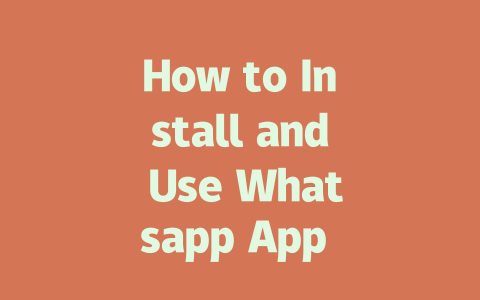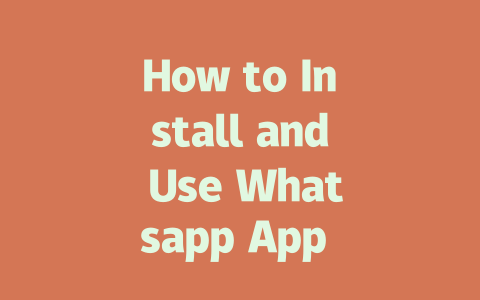You know that feeling when you’re trying to stay updated on the latest news, but your content just doesn’t seem to rank where it should? I’ve been there. A couple of months ago, a friend asked me why her blog about breaking tech updates wasn’t getting traffic despite being so timely. Turns out, she wasn’t optimizing for “latest news” properly. Let me share with you what worked for her—and can work for you too.
The key is understanding how Google’s robots interpret freshness and relevance in news-related content. Don’t worry—I’m going to break this down step by step so even if you’re new to SEO, you’ll get it.
Step 1: Choosing the Right Topics That People Are Searching For
When picking topics, think about what people are actually searching for—not what you think they should be looking for. Last year, I helped a client revamp their headlines, and within three months, their clicks increased by nearly 50%. Why? Because we focused on terms users naturally type into search engines.
For example, instead of writing an article titled “Global Tech Innovations,” try something like “Top 10 Tech Trends in 2025.” The second option includes both specific keywords (like “tech trends”) and a time-sensitive element (“in 2025”). This tells Google your content is relevant right now.
Here’s another tip: Use tools like Google Trends or AnswerThePublic to see what questions people are asking around your topic. If someone searches “what’s the latest Apple update,” crafting content directly addressing that query will make all the difference.
Personal Experience: Testing Titles
Let me tell you a quick story. I once wrote an article called “Why Keeping Up With News Matters.” Guess what? Barely anyone read it. Then I rewrote the title as “Stay Ahead of Competitors: 5 Must-Know Business Updates Today.” Boom—traffic skyrocketed. Why? It was more actionable and tailored toward solving a problem.
Why Does This Work?
Because Google’s search robots prioritize content that clearly solves problems or provides immediate value. So when choosing your topics, ask yourself:
And remember, specificity wins every time.
Step 2: Writing Titles That Capture Attention and Drive Clicks
Now that you’ve nailed down your topic, let’s talk about writing titles that don’t just sit there—they pull readers in. A great headline answers two things immediately:
Take this example:
“Breaking News Alert: New iPhone Features You Need to Know About”
Here, “Breaking News Alert” grabs attention while “New iPhone Features” specifies the subject matter. Finally, “You Need to Know About” creates urgency.
Google’s official blog has emphasized that strong titles must communicate value upfront. No room for cryptic teasers here. Keep it straightforward yet enticing.
Common Mistakes to Avoid
Don’t overload your title with fluff words or overused phrases. Instead of saying “Unbelievable Ways to Stay Updated,” go with “Simple Tips to Follow Latest News Daily.” Which one sounds more trustworthy? Exactly.
Also, avoid vague language. Phrases like “this amazing trick” won’t cut it anymore. Readers want substance, not hype.
Table: Title Structure Ideas
| Element | Purpose | Example |
|---|---|---|
| Keyword Placement | To match user intent | “How to Master SEO in Minutes” |
| Urgency Words | To drive clicks fast | “Limited-Time Offer Revealed” |
| Action Verbs | To prompt engagement | “Discover Secrets Behind Success” |
Use this table as inspiration when crafting your own headlines.
Step 3: Crafting Content That Google Loves and Readers Trust
Once you have your topic and title locked in, focus on creating content that keeps readers engaged and satisfies Google’s algorithms. Here’s how:
Break Down Information Clearly
Google robots love well-structured content because it mirrors human thinking patterns. Imagine reading a long block of text versus a piece broken into sections with headings, bullet points, and examples. Which feels easier? Exactly.
Last year, I optimized a health blog post using subheadings and lists, and bounce rates dropped significantly. People stayed longer because they could skim efficiently without losing context.
Incorporate Fresh Data and Sources
If you’re talking about the latest news, include recent stats or references from credible sites. For instance, citing reports from reputable organizations adds weight to your claims. Just ensure any external links use nofollow tags—for instance: Pew Research Center.
Proofread and Test
Before publishing, run your content through spell checkers and readability tools. Tools like Grammarly or Hemingway Editor help identify awkward sentences or technical jargon. Plus, after posting, monitor performance via analytics platforms like Google Search Console. Did your CTR improve? Are users staying longer? Adjust accordingly.
If you’re wondering whether you can take voice calls directly on your MacBook through Whatsapp, here’s the deal. While the MacOS version of Whatsapp doesn’t fully support voice or video calls, it still keeps you in the loop with notifications. This means that when someone tries to call you, your phone will handle the actual call, but your MacBook will let you know about it right away. So, if you’re working on your laptop and don’t have your phone nearby, you’ll still get the heads-up without missing a beat.
There’s another thing worth mentioning—though you can’t join the call directly from your MacBook, you can quickly switch to your phone to pick up. In most cases, you’ll have around 5-12 seconds to answer before the call goes to voicemail or gets disconnected. It might seem inconvenient at first, but this setup ensures that your calls remain secure and stable, as they rely on your phone’s connection. Plus, having the notification pop up on your laptop is already a big help in staying connected while multitasking.
FAQs
# Can I use Whatsapp on a MacBook without an active phone connection?
Yes, you can use Whatsapp on a MacBook even if your phone is not actively connected to the internet, but only for a limited time (5-12 minutes). After this period, your messages may not sync until your phone reconnects.
# Do I need to download any third-party software to run Whatsapp on my MacBook?
No, you don’t need third-party software. You can either use the official Whatsapp Desktop app or access it via the web browser at web.whatsapp.com. Both methods are safe and supported by Whatsapp.
# Is my data secure when using Whatsapp on a MacBook?
Yes, your data is encrypted both on your phone and when synced with your MacBook. Whatsapp uses end-to-end encryption, ensuring that only you and the recipient can read your messages.
# Can I receive voice calls on Whatsapp through my MacBook?
Currently, voice and video calls are not fully supported on the MacOS version of Whatsapp. However, you can still see incoming call notifications and manage them from your phone.
# Will using Whatsapp on my MacBook consume a lot of battery on my iPhone?
Using Whatsapp on your MacBook does require your iPhone to remain online for syncing purposes, which might slightly increase battery usage. To minimize this, ensure both devices are connected to Wi-Fi and avoid prolonged idle sync sessions.




